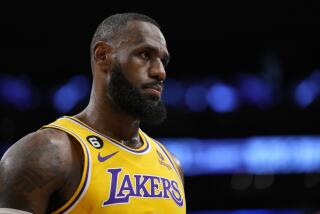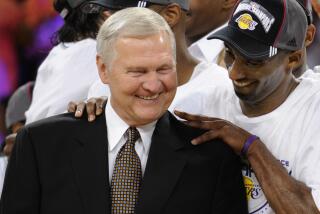Court Jesters
- Share via
Watching the Los Angeles Lakers in the NBA playoffs this spring has been like watching that nutty couple from next door walking arm-in-arm down your street. There was a time when all you heard coming from their window was the sound of flying pots and flailing invectives. Now all you see is love. You want to applaud them, you want to embrace them, but, mostly, you want to ask them: So what happened?
In “Ain’t No Tomorrow: Kobe, Shaq, and the Making of a Lakers Dynasty,” Elizabeth Kaye answers that question the way the nosy organizer of the annual block party might. There’s some juicy new dish; there’re some unexplained rumors; mostly, though, there’s a harmless recounting of the war, the truce and the 2001 Laker championship forged by a cocky David--Kobe Bryant--and an anxious Goliath--Shaquille O’Neal.
Kaye, a respected freelancer who spent quality time with the team, attempts to make sense of it all with a final note about the logo painted on the floor of the team’s practice facility. Instead of neatly spelling HEALTHSOUTH--the name sponsor of the building--the letters were irregularly arranged around center court as “HEALTHSOUTH.”
“Seen from a distance, for a moment these letters appeared to spell out the legend HEAL THYSELF,” Kaye writes, in conclusion. “That’s not what they said. But it’s what happened.”
It is a wonderful observation that applies to the current Lakers, a team that is difficult to read and impossible to understand. Kaye makes a good effort, but the problem with “Ain’t No Tomorrow” is a problem related to the peculiar position the Lakers occupy in a city and a society defined by the Hollywood entertainment machine.
No longer just basketball players, Bryant, O’Neal and the gang are movie stars with million-dollar contracts guaranteed far beyond the life of an average flick. They don’t need Kaye. They don’t need the media. They don’t even need their fans. They have no reason, financial or otherwise, to offer the public any sort of peek into their souls.
So, unlike the Showtime Lakers of two decades ago and in spite of the best efforts of writers such as Kaye, the Lakers of today remain elusive and enigmatic. We don’t know them, and we never will.
Kaye clearly worked hard and scratches the surface here with some interesting information that paints both sides of a feud that will remain with the Lakers as long as Bryant and O’Neal are each wearing a uniform. In fact, it is their competing personalities that lie at the heart of each Laker success and disappointment.
Some would say it was O’Neal’s fault. Kaye writes about the team bus passing a huge billboard featuring Bryant, at which point many on the bus glanced back at O’Neal because they knew he was jealous and his jealousy often got in the way of his game. She also writes about the time coach Phil Jackson called out O’Neal in the locker room for partying too hard, one of the best fresh stories here.
Others would say it was Bryant’s fault. She writes about guard Ron Harper challenging Bryant to a fight if he did not pass the ball. She recounts that poignant moment when Bryant apologized to the team for taking too many shots. There is also a compelling scene when Jackson stopped a team bus and canceled practice because of Bryant’s repeated insistence on hogging the ball during a recent game.
Kaye describes both players stooping to the level of whining children, which is nothing we didn’t already suspect. The real problem is she doesn’t tell us how they came to behave like men. The guess is she wasn’t able to uncover that information.
She did much better with Jackson, taking us into his home and into his head, allowing, for example, us to witness Jackson’s apology to Bryant for that now-famous interview in which he claimed that Bryant would sabotage his high school games so he could be the hero in the final minutes.
But we never learn how Bryant felt about the apology, only that he nodded. In another instance, she writes about the rumor that O’Neal used hand signs to order teammates to keep the ball away from Bryant, but she never tells us if the story was true.
For a book that is episodically told, these stories read like non sequiturs, portions of which we know. In a notable exception, Kaye recounts Bryant’s late-season dinner last year with Jerry West, the moment when Bryant finally realized that the Lakers could win only if he became a team player.
“I’d hate you, too, if I was your teammate,” West reportedly told him. Though the dinner was public knowledge, that quote is new. If only the book contained more of the same.
While Kaye clearly worked overtime on this book, the Lakers in the end proved as difficult to examine as they are to score upon. But parts of the book are great fun. One of my favorite anecdotes--one of Kaye’s three-point baskets--describes the time the rascal Isaiah Rider missed the Laker bus to the last game of the NBA finals in Philadelphia last year. While providing light, easy-chair accompaniment during the commercials in this spring’s playoffs, “Ain’t No Tomorrow” somehow misses that same championship bus.
More to Read
All things Lakers, all the time.
Get all the Lakers news you need in Dan Woike's weekly newsletter.
You may occasionally receive promotional content from the Los Angeles Times.







